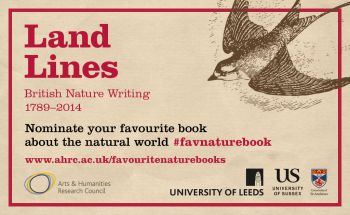Finding the UK’s favourite nature book
By: Rose Tremlett
Last updated: Wednesday, 13 December 2017

Which nature book is a real favourite? Or maybe inspired a life-long love of wildlife?
The diversity and influence of nature writing has never been so great and Land Lines, a major new research project, is asking people across the UK to help find the nation’s favourite book that captures our special relationship with the natural world.
Stretching from Gilbert White’s seminal The Natural History of Selborne back in 1789 to Helen Macdonald’s soaring and award-winning H is for Hawk in 2014, this pioneering project will look at how nature writing in this country has changed over the last 200 years, and what it might say about the world today and our connection with nature.
Land Lines is funded by the Arts and Humanities Research Council (AHRC) and is being undertaken by the Universities of Leeds, St Andrews and Sussex over the next two years.
Everyone can take part in the national survey by going to www.ahrc.ac.uk/favouritenaturebooks and nominating their favourite UK work on nature – along with up to 100 words about why they have chosen it. Entry is open from 25 October to 30 November, after which an expert panel will take these suggestions and compile a shortlist of 10 popular books. Then in January, an online vote will decide the nation’s favourite piece of nature writing.
Watch the University of Sussex's Dr Will Abberley launching the search and talking about his favourite nature book:
Many people would say a particular book sparked a love of the natural world or indeed changed their life, including:
Chris Packham, The Peregrine Falcon by Derek Ratcliffe
“It begins ‘When, as a small boy, I first became interested in birds, my imagination was fired by the pictures of a fierce-looking and beautiful bird of prey which the books said was rare, nesting only on the most formidable cliffs, and surpassing all other birds in its powers of flight.’ Yes, yes, yes!
“I was half way through (the book) by the time the roast was served, and it was done before the Boxing Day bubble-and-squeak. I had been ‘doing’ textbooks since I was six or seven, they injected me with knowledge; I needed to know ‘The Peregrine Falcon’ and I couldn’t get to know it in suburban Southampton. Derek obliged, big time. The truth is beautiful: graphs, tables and maps are just as magical as poetry.”
Cerys Matthews, Wild Food by Roger Phillips
“We moved to Swansea when I was seven, to a house which edged onto a small copse full of rusting prams and damp mattresses. This book, my bible, turned it from a dump to a wonderland full of things to recognise, study, name, cherish and sometimes collect and eat – mushrooms, nettles, sorrel. Phillips is a generous writer, and in this case photographer too, opening the door to everyone (of all ages) to the wonders and adventures of the natural world. I’ve never tired of it.”
Other suggested nominations have come from Gillian Burke, Julia Donaldson, Wainwright Prize winning John Lewis Stempel, Miranda Krestinkoff, Virginia McKenna, Michael Morpurgo, Fiona Reynolds and Alan Titchmarsh.
What is so distinctive about nature writing, and what does it say about the changing face of Britain and our relationship with the natural world? And how does it address today’s pressing environmental challenges? The two-year literary and environmental history research project, Land Lines will get to grips with how nature writing engages with the modern world rather than taking an idealised view.
Professor Graham Huggan, Land Lines research lead at the University of Leeds, said: “Nature writing is probably as popular now as it has ever been. This, the first major study of its kind, will explore how our attitudes to the natural world have changed over the years.
“We’ll also be investigating how people’s feelings about nature have been influenced by their reading, and this survey will kick start a national conversation about just that.”
This new and timely research project spans the ‘modern’ period from 1789 to 2014, and the authors to be studied are both well-known and less familiar. These are writers whose passion and love of nature have shaped our view of the world around us, including John Clare, Dorothy Wordsworth, J A Baker, Edward Thomas, Kenneth Graham, Sarah Perry, Flora Thompson, Richard Jefferies, Robert Macfarlane and Helen Macdonald, among many others.
Mike Collins, Head of Communications from the Arts and Humanities Research Council, who helped develop the idea, said: “In the last decade books about nature have flown off the shelves, and now have a prominent place in bookshops. It seems that nature writing is very much speaking to the time we live in, with the power of words helping us to rekindle a love of nature, and find comfort in a rapidly changing world.
“Curiosity-driven research such as the Land Lines project helps us to understand our place in the world. And writers play a key role in navigating us through the challenges of our age – with environmental change being one of the biggest.”
To mark the end of the project, an international conference on nature writing will be held in 2019. During the research there will also be public exhibitions and workshops across the country. These will stimulate conversations around what nature writing is, why people read it, how it might change the way they think about nature, and what its role might be in these ecologically troubled times.
Out of this work, the first definitive book on modern British nature writing will be published by Cambridge University Press. This will compare nature writing across different historical periods while assessing its changing character over time.
To find out more about the Land Lines project, visit www.landlinesproject.wordpress.com / @LandLinesNature

